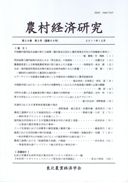Volume 37, Issue 2
JOURNAL OF RURAL SOCIETY AND ECONOMICS
Displaying 1-12 of 12 articles from this issue
- |<
- <
- 1
- >
- >|
Cover
-
2020 Volume 37 Issue 2 Pages 0
Published: February 01, 2020
Released on J-STAGE: August 24, 2022
Download PDF (433K)
Articles
-
Article type: research-article
2020 Volume 37 Issue 2 Pages 1-9
Published: February 01, 2020
Released on J-STAGE: August 24, 2022
Download PDF (914K) -
Article type: research-article
2020 Volume 37 Issue 2 Pages 10-20
Published: February 01, 2020
Released on J-STAGE: August 24, 2022
Download PDF (978K) -
Article type: research-article
2020 Volume 37 Issue 2 Pages 21-30
Published: February 01, 2020
Released on J-STAGE: August 24, 2022
Download PDF (727K) -
Article type: research-article
2020 Volume 37 Issue 2 Pages 31-40
Published: February 01, 2020
Released on J-STAGE: August 24, 2022
Download PDF (1291K) -
Article type: research-article
2020 Volume 37 Issue 2 Pages 41-51
Published: February 01, 2020
Released on J-STAGE: August 24, 2022
Download PDF (1725K) -
Article type: research-article
2020 Volume 37 Issue 2 Pages 52-60
Published: February 01, 2020
Released on J-STAGE: August 24, 2022
Download PDF (1203K) -
Article type: research-article
2020 Volume 37 Issue 2 Pages 61-71
Published: February 01, 2020
Released on J-STAGE: August 24, 2022
Download PDF (1248K) -
Article type: research-article
2020 Volume 37 Issue 2 Pages 72-80
Published: February 01, 2020
Released on J-STAGE: August 24, 2022
Download PDF (1082K) -
Article type: research-article
2020 Volume 37 Issue 2 Pages 81-88
Published: February 01, 2020
Released on J-STAGE: August 24, 2022
Download PDF (1016K)
Obituary
-
Article type: obituary
2020 Volume 37 Issue 2 Pages 89-90
Published: February 01, 2020
Released on J-STAGE: August 24, 2022
Download PDF (533K)
Back cover
-
2020 Volume 37 Issue 2 Pages 91-92
Published: February 01, 2020
Released on J-STAGE: August 24, 2022
Download PDF (533K)
- |<
- <
- 1
- >
- >|
